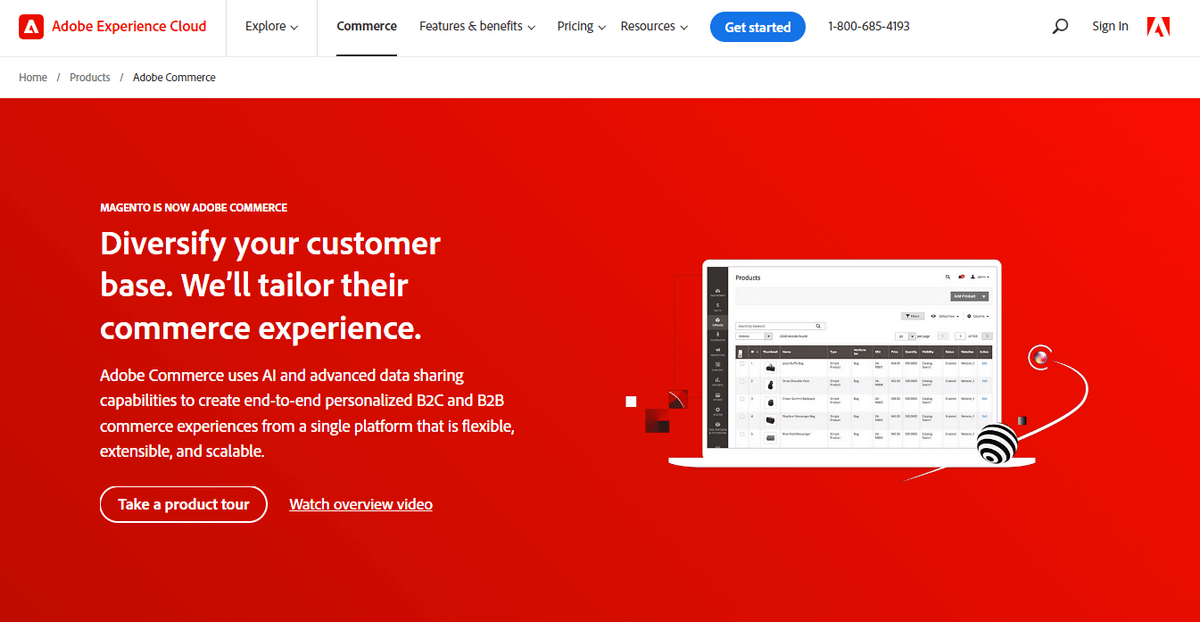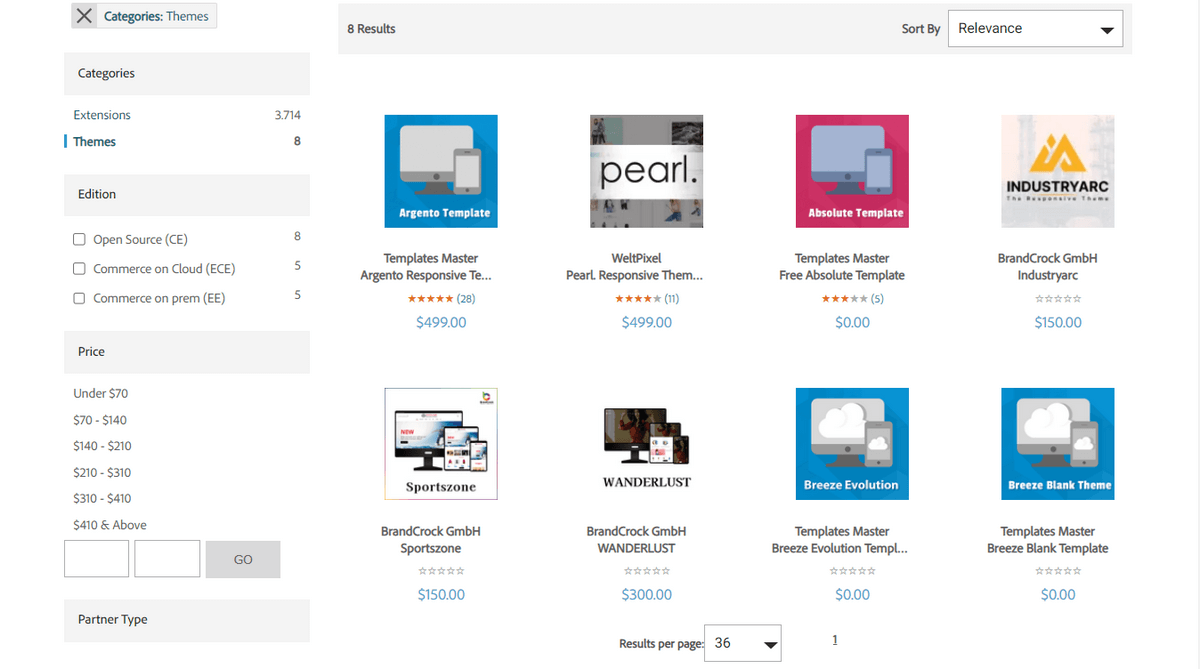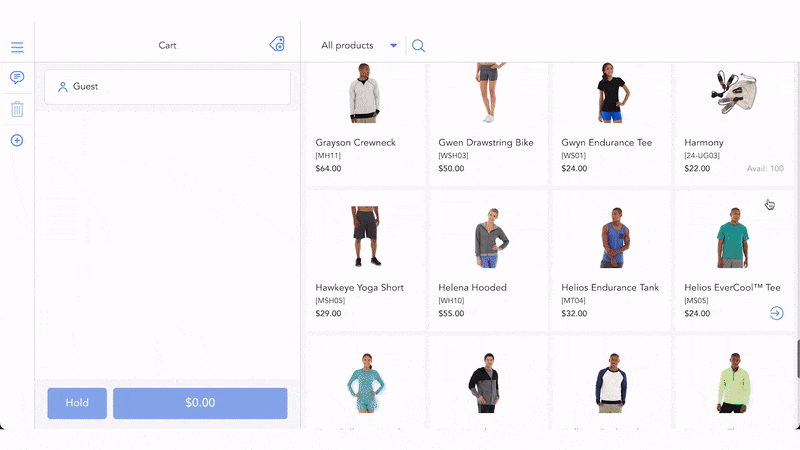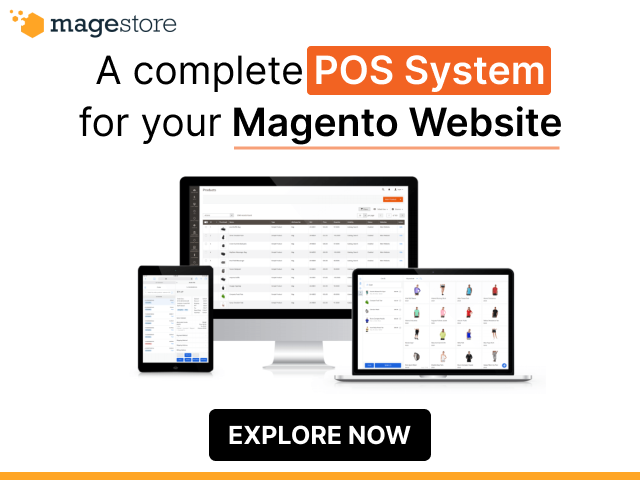Magento is now Adobe Commerce, and it’s part of the Adobe Experience Cloud. This change was officially announced by Adobe and Magento on April 21, 2021, almost three years after Adobe acquired Magento for a staggering $1.68 billion in 2018. This brought together their shared goal of delivering unique digital experiences.
The collaboration of Adobe Commerce Magento holds the potential to revolutionize shopping experiences across various industries and channels. It’ll captivate both Adobe fans and loyal Magento users. Join us to explore how this acquisition can take your eCommerce business to a new height in 2025.
A summary table of Magento editions
Magento is available in 3 different editions. The pricing for each edition depends on various factors, such as the features, hosting, themes, and customizations you need. Below are some information and rough estimates of the cost for each:
Edition name | Previously called | Abbreviation | Pricing | Release date |
Magento Open Source | Magento Community Edition | Magento CE | $0 – $15,000/year ($0 doesn’t include domain name, web hosting, backups, security, etc.) | June 24, 2008 |
Adobe Commerce |
| Magento EE | $22,000 – $125,000/year (Based on your annual gross merchandise value (GMV) and average order value (AOV)) | April 15, 2009 |
Adobe Commerce Cloud |
| Magento ECE | $40,000 – $200,000/year (Based on annual GMV and AOV, including hosting) | April 12, 2016 |
What is Adobe Commerce?
Adobe Commerce, powered by Magento, is an open source eCommerce platform. Adobe Commerce now is part of the Adobe Experience Cloud, a suite of products for creating personalized digital experiences across various channels and devices.

Source: Adobe
With Adobe Commerce Magento, merchants can create and manage B2C and B2B online stores with rich features, functionality, and customization options. It also integrates with other Adobe products like Analytics, Real-Time CDP, and Experience Manager. This integration enables data-driven insights, personalization, and optimization for eCommerce.
The latest Adobe Commerce recently leverages AI and advanced data-sharing capabilities to deliver personalized shopping experiences from a flexible, extensible, and scalable platform.
Key features of Adobe Commerce
Magento Adobe Commerce has many features to help you create world-class B2C and B2B shopping experiences. Here’re some outstanding Adobe Commerce features, but not limited to:
- Seller-assisted shopping: Sales representatives or customer support agents can log in to customers’ accounts and help them place orders.
- Live search: This enables customers to search for products on the fly with instant results while an AI-driven algorithm takes care of the results’ relevance.
=> Read more: 9 ultimate Magento live chat extensions for 2025 starting at $0
- Product recommendations: You can leverage Adobe Sensei’s machine-learning capabilities to deliver personalized product recommendations to your customers based on their behaviors and preferences.
- Page builder: This feature allows you to create and edit content pages by using a drag-and-drop interface with design and preview features. You can also use Adobe Commerce page builders to create dynamic blocks inserted into any page.
Source: Adobe Experience Cloud
- Catalog service: You can manage your product catalog across multiple websites and stores using a single source of truth. You can also utilize Catalog to optimize your catalog performance, such as indexing, caching, and filtering.
- Inventory and order management: With Adobe Commerce download, you can keep track of inventory, see its availability in real time, and deliver orders on your customers’ expectations across all channels.
- Store fulfillment: The platform allows you to optimize your order fulfillment process by connecting your online and offline channels. Besides, Store Fulfillment enables click and collect, ship from store, and inventory reservation options for your customers.
- PWA studio: This feature lets you create progressive web apps (PWAs) that deliver fast, engaging, and mobile-friendly shopping experiences.
- Customer segmentation: With this capability, targeting different customer groups based on their attributes and behaviors has never been easier. Then, you can use this data to create personalized content, promotions, pricing, and more for each segment.
- Business intelligence: Adobe allows you to centralize all your eCommerce data, including POS reporting. They can visualize the raw data into charts, graphs, and other forms to help users understand complex data patterns. Besides, users can leverage BI to gain insights into cross-channel trends, sales performance, inventory management, customer behaviors, marketing effectiveness, and more.
- Cloud delivery: This will empower you to operate your eCommerce store with confidence in cloud-based services with continuous releases, monitoring, development tools, and deployment efficiencies. Not to mention, you’ll gain access to Adobe’s robust security measures and PCI compliance service, ensuring the protection of your online business and customer data.
- Seamless integration: Adobe B2B Commerce integrates with various 3rd-party applications and services, including payment gateways, shipping providers, and CRM platforms. Besides, Adobe Commerce ERP integration enables seamless synchronization of inventory, orders, customer data, and shipping details between these vital operations.
- Payments and financing: Adobe Commerce payments allow you to centralize payment and order data from all your storefronts, ensuring you have the cash on hand when needed.
Pros | Cons |
|
|
=> Might you like: Adobe Commerce POS by Magestore: A Magento-native POS solution with fast checkout, real-time inventory sync, advanced omnichannel retail, seamless ERP integration, and flexible customization.
Adobe Commerce vs Magento Open Source
Adobe Commerce and Magento Open Source are built on the Magento codebase, written in PHP. While Magento vs Adobe Commerce shares a common foundation, there are notable differences in features, functionality, and pricing. Here’re the key distinctions:
- Adobe Commerce is a paid and premium option that offers an extensive range of features and functionalities. These features include drag-and-drop CMS, B2B capabilities, performance optimization, built-in marketing tools, mobile commerce capabilities, and more.
The platform also provides managed cloud services, support, and security for your eCommerce store. Hosting, maintenance, updates, backups, and patches are taken care of, alleviating your concerns. Additionally, Magento Commerce grants access to products and services of Adobe Ecosystem, such as Adobe Experience Manager, Adobe Analytics, Adobe Target, etc.
- On the other hand, Magento Open Source (CE) is a free, open source option suitable for small and medium-sized businesses. It allows you to enhance your store’s functionality through extensions but requires more technical skills and resources for management and customization. Furthermore, this edition lacks some of the exclusive features that Adobe Commerce offers.
With Magento CE, you’re responsible for handling everything from hosting and support to backend operations such as payments, shipping, order management, and logistics. Security issues and updates also fall under your purview. While this provides more flexibility and control over your store, it also entails additional responsibility and risk.
Adobe Commerce | Magento Open Source | |
License cost | Based on average gross sales revenue | Free |
Features | Extensive and advanced | Basic functionality |
Hosting | Managed cloud services included | Self-hosted or 3rd-party hosting providers |
Content management | Drag-and-drop interface with design and preview features | Require coding skills or extensions |
B2B functionality | Built-in features to support B2B sales include company accounts, quotes, requisition lists, etc. | Limited functionality |
Marketing features | Built-in features to support marketing campaigns, such as promotions, coupons, reward points, gift cards, etc. | Require coding skills or extensions |
Segmentation & personalization | Advanced capabilities to target customers based on attributes and behaviors | Limited functionality |
Performance optimization | Built-in features to improve speed, scalability, and reliability, such as Varnish caching, Elasticsearch, RabbitMQ, etc. | Require coding skills or extension |
Internationalization | Built-in features to support multiple languages, currencies, and tax rates | Require coding skills or extensions |
Mobile commerce | Built-in features to support the mobile-friendly design and PWA Studio | Require coding skills or extensions |
Adobe Ecosystem integration | Seamless integration with other Adobe products and services, such as Experience Manager, Analytics, Target, etc. | Require coding skills or extensions |
Support and security | Included with license fee | Self-managed or 3rd-party providers |
Technical skill requirement | Moderate to Advanced | Moderate to Advanced |
How much is Adobe Commerce?
As mentioned earlier, Adobe Commerce pricing is based on annual Gross Merchandise Value (GMV) and Average Order Value (AOV). GMV is the total value of merchandise sold over a given period. Meanwhile, AOV is the average amount each customer spends per transaction. The higher your GMV and AOV, the higher your Adobe Commerce license fee.
- Adobe Commerce price starts at $22,000 and goes up to $125,000 annually.
Average gross sales revenue | Adobe Commerce cost |
<$1M | < $22,000/year |
$1M – $5M | < $32,000/year |
$5M – $10M | < $49,000/year |
$10M – $25M | < $72,000/year |
25M+ | < $125,000/year |
- Adobe Commerce Cloud vs Adobe Commerce pricing differs slightly due to the inclusion of cloud backup and hosting services. It usually starts at $40,000 and up to $200,000 per year.
Average gross sales revenue | Adobe Commerce Cloud cost |
<$1M | < $40,000/year |
$1M – $5M | < $55,000/year |
$5M – $10M | < $80,000/year |
$10M – $25M | < $120,000/year |
25M+ | < $200,000/year |
In addition to the price of Magento Adobe Commerce, there are several monthly and one-time fees that you need to consider, but not limited to:
- Web hosting: Monthly fees ranging from $49 to $630.
- Domain: Annual fees ranging from $10 to $500.
- SSL certificate: Annual fees range from $49 to $1,000.
- Web developer: Hourly cost based on the expertise and location of the developer. This expense may vary depending on your specific requirements.
- Transaction fees: Payment platforms and credit card processing fees typically range from 2% to 4% per transaction.
And one-time expenses to consider, including
- Themes: Store themes can range from $0 to $499, while customized themes may cost $5,000 or more.
- Enhancements and addons: In the Adobe Commerce store, the cost of enhancements and addons can range from $0 to $2,000.

So, what can you get for that price?
Adobe Commerce platform offers two different packages:
- Adobe Commerce Pro is a comprehensive package that caters to merchants of any size or business model.
- Adobe Commerce Managed Services is a package that offers expert-level managed services to reduce risk and minimize disruptions. It includes everything in Adobe Commerce Pro, along with additional professional services.
Features | Adobe Commerce Pro | Adobe Commerce Managed Services |
Core application support | ✓ | ✓ |
Single-tenant dedicated infrastructure | ✓ | ✓ |
Deployment tools | ✓ | ✓ |
Dedicated staging environment | ✓ | ✓ |
Increased customization available | ✓ | ✓ |
50 GB of testing | ✓ | ✓ |
Disaster recovery and data retention | ✓ | ✓ |
Varnish-based CDN | ✓ | ✓ |
Image optimization | ✓ | ✓ |
✓ | ✓ | |
Performance monitoring tools | ✓ | ✓ |
Infrastructure support | ✓ | ✓ |
Technical account manager | ✓ | ✓ |
High availability architecture | ✓ | ✓ |
Automated data backup | ✓ | ✓ |
Expansive monitoring and alerting | ✓ | ✓ |
Scale globally on AWS and Azure | ✓ | ✓ |
Secure and dedicated cloud infrastructure | ✓ | ✓ |
Incident service level target | ✓ | ✓ |
Surge capacity monitoring and response | ✓ | ✓ |
Infrastructure security | ✓ | ✓ |
Infrastructure level 99.9% service level agreement (SLA) | ✓ | ✓ |
Application level 99.9% SLA | ✓ | |
30-minute service level target (SLT) for P1 | ✓ | |
Designated cloud infrastructure resource (Customer Success Engineer) | ✓ | |
Planned event management support | ✓ | |
Customized site monitoring and personalized run book | ✓ | |
Upgrade and patching development assistance | ✓ | |
Go-live process | ✓ | |
Dedicated escalation | ✓ | |
Application monitoring assistance | ✓ |
=> You might like: Magento pricing: The true cost of running a Magento website
Adobe Commerce integrations
Adobe Commerce offers seamless integration with various systems and tools to enhance the functionality and capabilities of your eCommerce store. Here’re some key integration options:
1. Integration with Adobe Experience Cloud
Adobe Commerce can be combined with Adobe Experience Cloud, offering comprehensive commerce solutions for B2B and B2C customers. This integration provides access to AI-driven personalization, content management, analytics, optimization, and more, allowing you to create streamlined customer experiences across different touchpoints.
2. System-to-system integration
You can integrate Adobe Commerce with various systems like ERP, CRM, PIM, OMS, WMS, CPQ, DAM, and more. The system providers offer pre-built connectors available on the Adobe Commerce Marketplace or from their own websites.
=> Read more: Magento integration with Salesforce
These connectors facilitate direct integration between Adobe Commerce and other essential business systems.
3. Integration with 3rd-party storefronts and channels
Adobe Commerce supports integration with various storefronts and channels through its GraphQL API. This includes integration with digital experience platforms, content management systems, progressive web apps, mobile native apps, point of sale systems, IoT devices, social channels, and live-stream commerce channels. The GraphQL API ensures efficient and agile deployment of new features specific to each channel, avoiding unnecessary data fetching.
Adobe Commerce roadmap
The Adobe Commerce roadmap outlines the future development and innovation plans for Adobe Commerce. It encompasses various aspects of the product, including features, integrations, cloud services, and more. Below are some highlights and updates from the Adobe Commerce roadmap for 2022 and 2023:
- Key themes and capabilities: AI and automation, API mesh, app builder, blue/green deployment, autoscaling, and more
- Notable investments: Adobe Experience Platform Connector for Adobe Commerce, Intelligent Categories, API Mesh, App Builder, Blue/Green Deployment, and Autoscaling
- Key themes and capabilities: Organic growth, Adobe Experience Platform connector for Adobe Commerce, intelligent categories, and more
- Product focus: Empower companies to harness data and AI for personalized commerce experiences, scale growth with a high-performance cloud solution, and adapt to any opportunity with a flexible and composable platform.
Conclusion
The change from Magento to Adobe Commerce has brought many business improvements and advantages. Adobe Commerce is now a powerful eCommerce platform combining the best of Magento with Adobe’s capabilities. It offers many features, customization options, and easy integration with other Adobe products.
With this combination, businesses can provide outstanding digital experiences to their customers. By taking advantage of its features, integrations, and future plans, businesses can stay competitive, grow, and deliver exceptional commerce experiences.
Learn more Magestore products and services. Thank you for reading, and happy selling!
FAQs
1. What is Adobe Commerce used for?
Adobe Commerce is used for creating and managing online stores. It enables businesses to build customized, secure, and scalable eCommerce websites, manage inventory, process payments, and implement marketing campaigns to deliver exceptional online shopping experiences for B2C, B2B, and B2B2C.
2. What are some competitors of Adobe Commerce?
Top Adobe Commerce competitors include:
- WooCommerce
- OpenCart
- Shopify Plus
- BigCommerce
- Wix
- Salesforce Commerce Cloud
- SAP Commerce Cloud
3. Is Adobe Commerce better than Shopify?
When comparing Adobe Commerce vs Shopify, it’s challenging to determine which one is better as both platforms provide outstanding features for entrepreneurs to establish and sell products online.
Shopify is particularly beneficial for new entrepreneurs on a budget, thanks to its user-friendly interface and simplicity.
On the other hand, Magento (Adobe Commerce) caters to businesses of all sizes that prioritize customization and personalization. It provides more flexibility and advanced features to meet specific business needs.
4. Is Adobe Commerce free?
No, Adobe Commerce is not free. It’s a premium eCommerce platform that offers advanced features and functionalities. Magento Adobe pricing depends on many factors, such as average gross sales revenue, business size, and specific requirements.
5. When did Adobe buy Magento?
Adobe bought Magento on August 21, 2018, for a staggering $1.68 billion.














Great insights on the transition from Magento to Adobe Commerce! It’s exciting to see how this change will impact the e-commerce landscape. I’m particularly interested in the new features and tools that Adobe plans to integrate. Looking forward to seeing how businesses adapt to this evolution!
The transition to Adobe Commerce seems like a huge win for eCommerce businesses! With the integration into Adobe Experience Cloud, I’m curious how the use of AI and machine learning will further enhance personalized shopping experiences. Do you think these technologies will enable even more advanced predictive analytics?
Great insights on the transition from Magento to Adobe Commerce! It’s fascinating to see how Adobe’s integration will enhance the e-commerce experience. I’m particularly excited about the potential for AI-driven personalization. Looking forward to seeing how this evolves in 2025!
Great insights into the rebranding transformation from Magento to Adobe Commerce! It’s exciting to see how Adobe plans to enhance the platform and provide more tools for eCommerce businesses. Looking forward to seeing the new features and improvements in 2025!